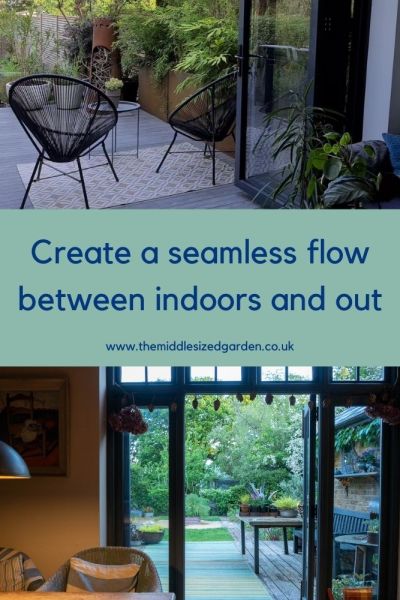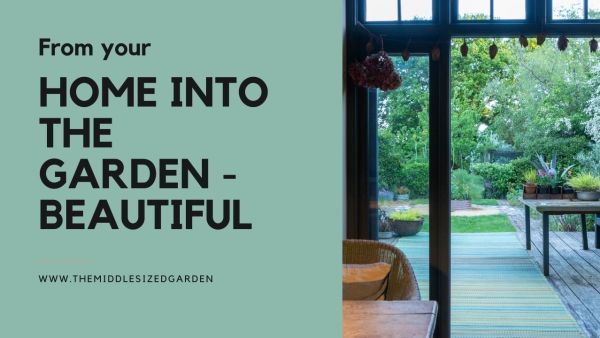How to connect your indoor and outdoor space successfully
Many of the most successful garden designs link indoor and outdoor space by using colour, materials and even furniture to create a seamless transition.
Sometimes it’s called ‘blurring the boundaries’ between house and garden.
I spoke to two people with very different garden styles, but who both successfully connect their homes and gardens. Francine Raymond is a gardening writer and author. Her website is called Kitchen Garden Hens. Lisa Feurtados has a garden design company and shop, both called Fuchsia Green.
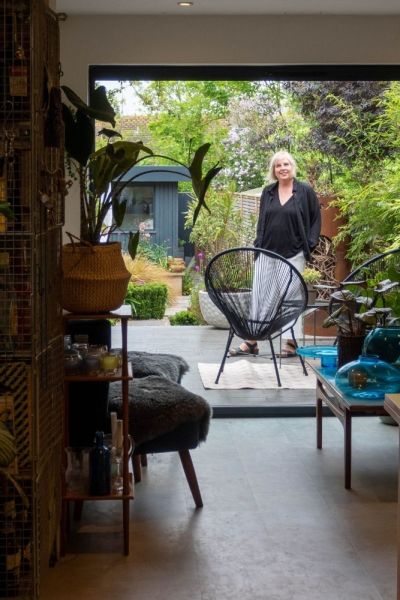
Lisa’s house and garden flow seamlessly into each other – from jungly houseplants and mid-century modern furniture styles in both the kitchen and the deck.
Both Francine and Lisa are part of Whitstable Open Gardens, so you can see their gardens in person. They’re among the 12 Whitstable Joy Lane gardens opening for the NGS on May 22nd. There are a further 12 Whitstable Town gardens opening on July 3rd. And Whitstable is a charming seaside town, with lots of good pubs and restaurants, so these are two great days out for garden lovers.
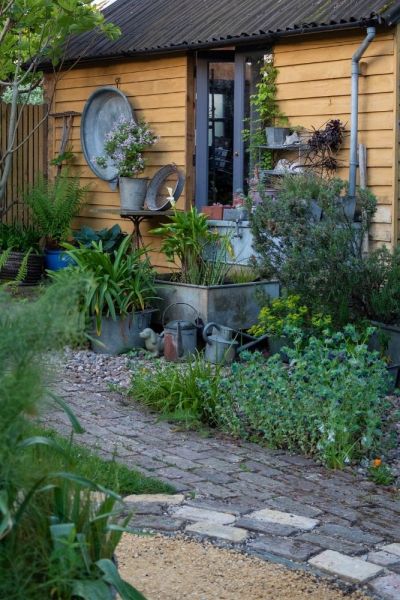
Francine’s style is based on a seaside sandy yellow, dark grey and vintage finds.
There are thousands of private gardens open for the NGS around England and Wales. You can find a garden near you here.
Start with your house
If you’re doing a major home renovation or extension, Lisa recommends you finish it before doing your garden or hiring a garden designer.’Sometimes clients ask me to design their garden before they have work on the house done. But I always advise them that the garden design starts with the house. You may change your mind or do things differently from the original plan.’
If you want your indoor and outdoor space to flow naturally from one to the other, then interior flooring or colour choices may be the inspiration for the garden, Lisa says. ‘It’s so important that the garden is right for the house or for the style of the people who live there.’
Connect indoor and outdoor space with glass doors
When Francine bought her house, there was just a standard door out onto a concrete space. So she had French windows – double glass doors – made in the style of the house. If you have a more contemporary taste, you can do the same with today’s modern bifold doors. Either will give you a year-round view of the garden.
She also had the concrete yard covered in decking.
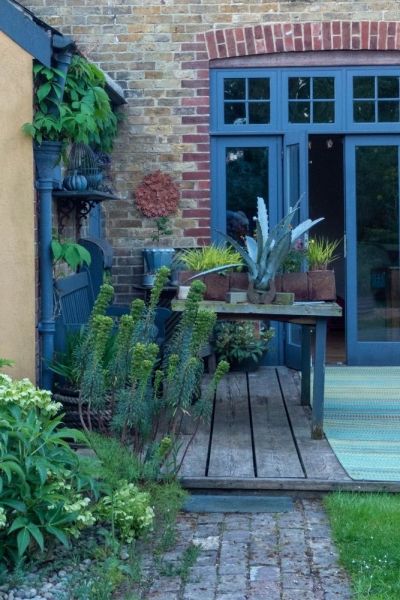
Francine’s French windows mean that she can see the garden all year round, while echoing the house’s architecture.
Think about indoor and outdoor flooring to link the spaces
If you have a room that opens onto the garden, think about making the space flow by using similar looking flooring material and pavers. It’s often not practical to take exactly the same flooring through from inside to outside, but pick a harmonious colour. Lisa has a pale grey floor in her kitchen, which leads onto a pale grey deck. Further down the garden, gravel and pavers carry the colour theme on.
This is a point also made by Pollyanna Wilkinson in this post on how to design a garden.
And Francine has used an outdoor rug on the deck near her house. It gives the sense that the deck is almost a room in the house.
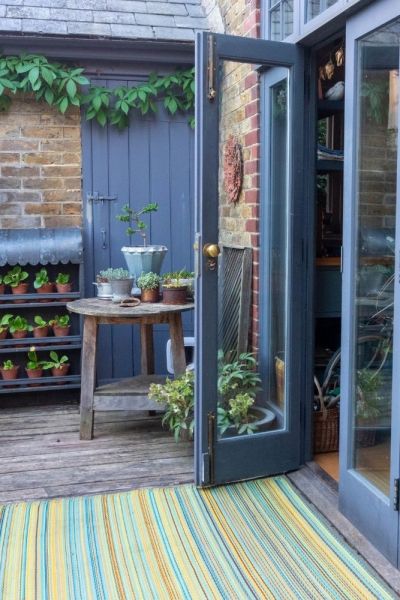
Francine was given the rug by a friend who was going to throw it out. It’s an all-weather rug and can be left out for the whole summer.
Link indoor and outdoor space by zones
Lisa has zoned both her kitchen and garden. The kitchen has a working zone, eating zone and relaxing zone. So she’s carried the zone approach out into the garden.
First, there is a deck directly outside the kitchen. The kitchen floor and the deck are a similar shade, and the furniture in both areas is monochrome and mid-century modern. The sofa inside and the chairs outside are both in 1950s styles and a similar dark grey colour.
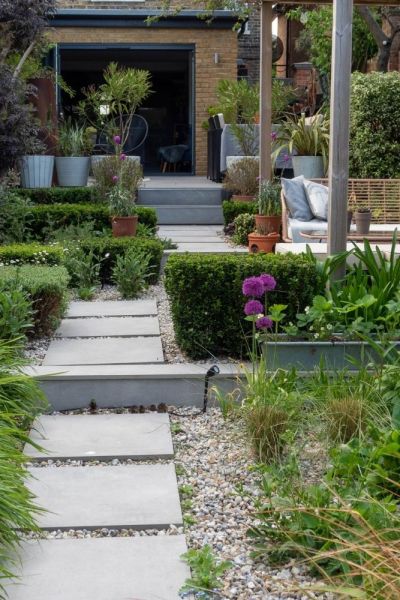
The deck is at the top by the house, then there is a zone for formal planting and another contemporary seating area.
The second garden zone is more formal, with evergreen strips of geometric euonymus. Formal garden design works well both in modernist and traditional spaces, so it’s a good choice for linking the mid-century modern theme of the deck with the wilder and more relaxed garden style at the end of the garden.
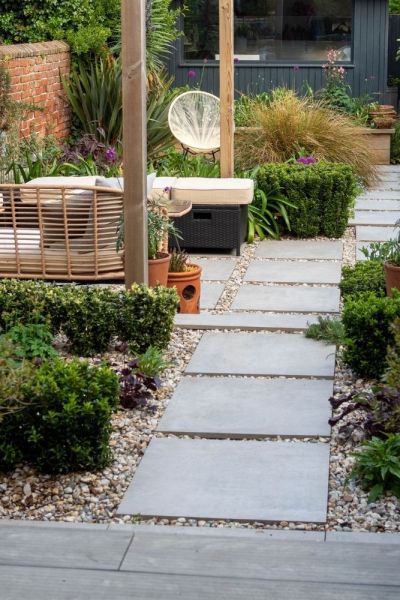
At the end of Lisa’s garden is an informal, wilder zone, and also her studio where she creates her garden designs.
Lisa’s house and garden are a typical Victorian terrace, so the house is tall and narrow, and the garden is long and thin. Zoning works particularly well in long thin spaces, but the principle works whatever shape your house and garden are.
Francine also divides her gardens into zones, with a more designed area close to the house, and getting wilder as she gets further from the house.
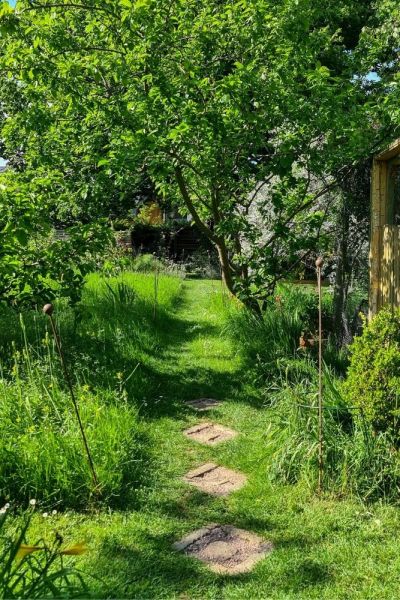
The path leading from the more formal area of Francine’s garden, through the meadow and down to the ‘woodland’ area at the end.
You don’t have to have the eating area directly outside the house, although it can be convenient. In 5 garden design tips and 2 to avoid, garden designer Charlotte Rowe suggests having the eating area where you get the best light and views rather than automatically placing it directly outside the back door.
Echo colours inside and out
Francine’s approach to linking the indoor and outdoor space is based on colour. ‘We’re on the coast and I have a yellow brick house with a grey slate roof,’ she says. So she has chosen a sandy yellow and blue-grey as signature colours. She shops from junk shops, antique markets and chain stores. And then she often paints them in one of these colours.
‘People say it’s so clever to have everything looking as if it fitted together like this,’ she says. ‘But it’s not clever at all. You just have a big pot of paint to hand, and you paint everything with it.’
It’s worth saying that she doesn’t paint everything as she also has a theme of galvanised metal/zinc. This is also in keeping with the ‘grey’ theme. So although she has lots of different sizes and shapes of pots, planters and objet trouves, they all look good together.
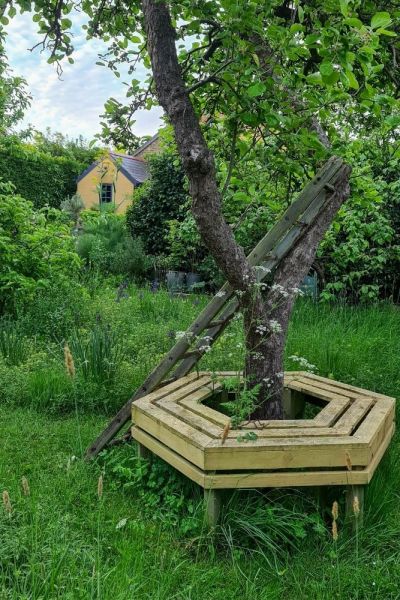
Francine’s signature yellow -it’s on the back of the house and on a bench round a tree in her meadow area.
Francine uses yellow and grey in the house, too. However, when it comes to planting and flower colour, she says she varies it from year to year. She enjoys experimenting with different colour combinations.
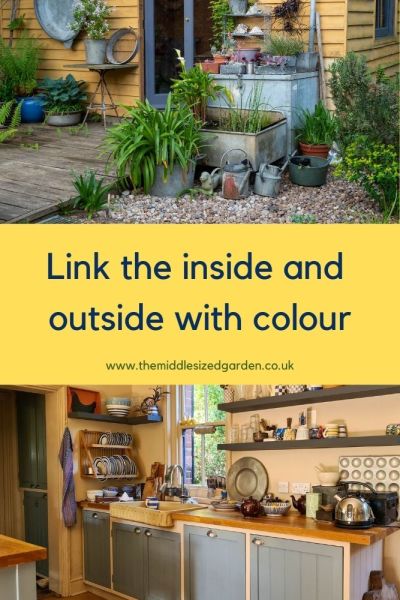
Francine’s yellow and grey in the kitchen and then on her garden room with her collection of vintage pots and containers. You can read how Francine turned her garage into a beautiful garden room on a tight budget here.
You can see more of both gardens and how they relate to the house in the video here.
Co-ordinate interior design with garden design
Lisa and her family like mid-century modern style. So the sofas and chairs in both the kitchen and on the deck immediately outside the kitchen are all mid-20th century styles.
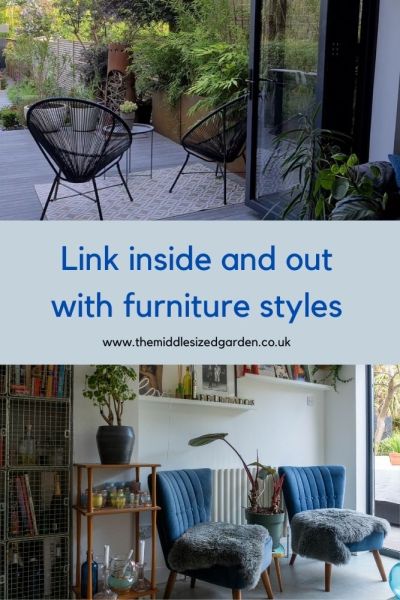
A mid century modern furniture theme links Lisa’s indoor and outdoor space.
You can even extend this with your choice of house plants and the plants you see immediately outside the house. For example, Lisa has quite big-leafed jungly house plants near the bi-fold doors, and picks up on the jungle theme with a big corten steel box of bamboo immediately outside on the deck.
Then as you go further away, down the garden, into the different zones, there’s more of a traditional English planting.
Use house plants indoors and outside
Lisa’s shop, Fuchsia Green, sells lots of house plants, so she’s very experienced in knowing which plant should go where. Placing house plants is like positioning plants in the garden, she says.
‘It’s like choosing garden plants – right plant, right place,’ she says. When you choose houseplants, take note of what conditions they need. Some house plants are happier in low light or can tolerate bright sun. Others are more resistant to draughts.
If you have big patio doors that are often open, then the house plants in that area will need to be able to deal with changes in temperature, too.
You can bring some plants inside in the winter and take them out onto the terrace in summer. See our post on indoor outdoor plants for 9 garden plants that also thrive as house plants.
Winter interest is key for linking indoor and outdoor space
‘You don’t go into the garden as much in winter,’ says Francine. ‘So it’s important to have something to look at from the house.’ She has a table directly outside her French windows which she uses to create winter interest. There is usually a display of evergreens and a small sculpture, for example.’
Lisa’s garden is more on view during the winter because the whole of the back of the garden is glass bifold doors. She uses evergreen planting and pots.
There are some winter planting ideas in the 10 best plants for a winter garden, and also winter container plant ideas here.
Visiting the gardens
You can book to visit these two gardens and ten others on May 22nd on the Whitstable Joy Lane open gardens here. I’ve also featured other Whitstable gardens on this blog, which are open on the second Whitstable Open Town Gardens day on the 3rd July, including one of the Middlesized Garden’s most popular posts about Emma and Mel’s long thin garden.
And there is also a group of five distinctive walled gardens open for the NGS in nearby historic Faversham on June 11th.
And on June 26th – the last Sunday in June, Faversham Open Gardens & Garden Market Day has 30 gardens open, with a delightful garden market in the medieval Market Place. Tickets are available online from the end of May from the Faversham Society or in the Market Place on the day.
Pin to remember linking indoor and outdoor space
And do join us for a free weekly email with more tips, ideas and inspiration for your garden.
